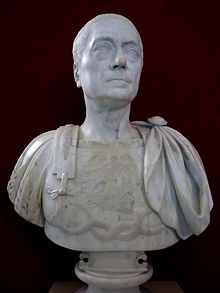Giuseppe Ceracchi
Giuseppe Ceracchi (born July 4, 1751 in Rome , † January 30, 1801 in Paris ) was an Italian sculptor .
Life
Giuseppe Ceracchi was the son of a goldsmith and a student of the Accademia di San Luca in Rome. From 1775 he stayed in London , where he created allegorical statues , decorative pictures, mythological compositions and a number of monuments. From 1790 he is recorded in Vienna , where he made a marble bust of State Chancellor Wenzel Anton Kaunitz for the decoration of the Belvedere Palace on behalf of Maria Theresa . Ceracchi received other commissions from Emperor Joseph II , such as the portrait busts of the imperial generals Gideon Ernst von Laudon and Franz Moritz von Lacy intended for the court war council , which are now in the permanent exhibition of the Vienna Army History Museum . According to the signature, both were modeled after life in Vienna and executed in marble in Rome in 1781 .
Ceracchi subsequently married Therese Schliesahan from Vienna. Further orders from the imperial family followed, e.g. B. two portrait busts of Emperor Joseph II and in 1784 a marble bust of Emperor Franz II / I. In 1785 Ceracchi went back to his hometown Rome, where he created numerous busts, mainly of representatives of the clergy . Ceracchi continued to work on behalf of the nobility until 1789, but afterwards he was so impressed by the reports of the French Revolution and the events in the United States that he mutated into an enthusiastic supporter of republican ideals of freedom and set off for North America in 1790. There, a year later, he offered the United States Congress a draft for a colossal monument to freedom, which, however, was not carried out due to a lack of funds. With smaller commissions, such as a portrait bust of George Washington and other well-known Americans, Ceracchi did not stay afloat for long, so that he returned to Europe in 1792, where he worked in Genoa , Milan and Paris. In 1796 Napoleon Bonaparte entered Milan triumphantly, which encouraged Ceracchi to make several portrait busts. The artist modeled further busts on behalf of Napoleon in Paris around 1800, including the generals Jean-Victor Moreau , André Masséna and Jean-Baptiste Jules Bernadotte .
On behalf of Napoleon, Ceracchi was also openly politically active, for example, agitating for the Roman Republic . A little later, however, he drew Napoleon's disgrace when Ceracchi publicly accused him of favoring the Pope ( Pius VII ). Thereupon the artist was arrested in 1801 in the Paris Opera and accused of a dagger attack on Napoleon. On January 30, 1801, Giuseppe Ceracchi was guillotined together with three co-conspirators in Paris .
Works (excerpt)
- Portrait bust of Franz Moritz Graf Lacy , 1783, marble, 59 × 24 × 77 cm, Heeresgeschichtliches Museum, Vienna
- Portrait bust of Gideon Freiherr von Laudon , 1783, marble, 59 × 24 × 77 cm, Heeresgeschichtliches Museum, Vienna
- Portrait statue of Anne Seymour Damer , around 1777, marble, British Museum
- Portrait bust of Elector Karl II of Bavaria , 1789, marble, Bavarian National Museum , Munich
- Portrait bust Amerigo Vespucci , White House , Washington, DC
- Portrait bust of George Washington , 1795, marble, Metropolitan Museum of Art , New York City
literature
- Ilse Krumpöck: The sculptures in the Heeresgeschichtliches Museum , Vienna 2004, p. 28 f.
- Ulrich Thieme (ed.): General lexicon of visual artists from antiquity to the present . Leipzig 1912, Volume 6, pp. 287-289.
Individual evidence
- ↑ Ilse Krumpöck: Die Bildwerke im Heeresgeschichtliches Museum , Vienna 2004, p. 28 f.
- ↑ Ulrich Thieme (ed.): General lexicon of visual artists from antiquity to the present . Leipzig 1912, Volume 6, pp. 287-289
- ↑ Johann Christoph Allmayer-Beck : The Army History Museum Vienna. Hall II - The 18th Century to 1790 . Kiesel Verlag, Salzburg 1983, ISBN 3-7023-4012-2 , p. 34
- ↑ on metmuseum.org , accessed December 7, 2012
Web links
| personal data | |
|---|---|
| SURNAME | Ceracchi, Giuseppe |
| BRIEF DESCRIPTION | Italian sculptor |
| DATE OF BIRTH | 4th July 1751 |
| PLACE OF BIRTH | Rome |
| DATE OF DEATH | January 30, 1801 |
| Place of death | Paris |


